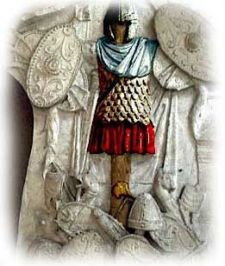 |
 |
| Home | Activity | Projects | Members | Reenactment | Media | Forum | Links | Contact |
|---|
 |
|---|
 ::Reenactment resources::
::Reenactment resources::
 |
|---|
|
Dacian weapons Several Roman sculptural monuments can be used as sources in the reconstruction of the number and shape of Dacian weapons: Trajan’s column, the monument in Adamclisi – Dobrudja, Romania, the inscriptions in Carlisle – United Kingdom and Grădiştea de Munte – Romania. Numerous archaeological discoveries and certain literary sources can also be employed to this end. Dacian weapons can be grouped in two main types, offensive (swords, battle knives, lances, spears, axes, bows and arrows) and defensive (shields, helmets, mail shirts, and leather cuirasses). Swords. Images on Roman reliefs and archaeological discoveries indicate that the sword was the Dacians’ main offensive weapon. They were of two types, with curved and straight wide blade. Curved swords, attested since the fifth and sixth centuries B.C. and used by a variable number of populations, became during the wars with the Romans the symbolic weapons of the Dacians. The term falx (fem.; pl. falces), designed during Antiquity all objects, of various size and shape, which shared a cutting edge placed on the inner side of their blade (sickles, bill-hooks, scythes, hooks). Falx sword blades measured between 70 and 100 cm, of which 20-40 cm corresponded to the handle. Their width extended between 3 and 5 cm. Since they were two-hand swords, the warriors using it were unable to protect themselves with a shield but were capable of striking powerful blows. The falx was a cutting and not a thrusting weapon. Straight swords had two cutting edges and pointed tips, their blades measuring between 4 and 6 cm in width. They were on average 75-95 cm long, of which the handle was up to 20 cm long. Some of these swords even had fullers. Straight swords were used both for cutting and thrusting. Another type of straight sword is attested, with only one cutting edge. Such weapons can be included in the category of short swords (50-55 cm), with handles up to 10 cm, being therefore appropriate for a one-hand grip. Daggers. Ovidiu Nasso, the poet exiled in Tomis, wrote: „Dacian men are always ready to use the knife they all carry by the hip to inflict wounds”. These knives are of two types: with straight and curve blades. In length they range between 23 and 26 cm. Just as the falx, the curved knife, the sica, became an ethnical Dacian weapons. Its blade is also sharp on the inside of the curve. Lances and spears are the most numerous and wide-spread Dacian weapons. The difference between them only consists in the dimension of the heads: the spears, as throwing weapons, ended in smaller heads (15-20 cm), while the lances were significantly larger, with heads often reaching 30 cm. In their proportions, spears were as tall as the warriors using them, while the lances measured up to 2.5 m. Both had shaft inserts with orifices through which their heads were nailed to the wooden shaft. At the opposite end, both types of weapons were strengthened with iron heels which conferred stability during throwing and a plus of protection when they were thrust in the ground against cavalry attacks. The battle axe is attested on the reliefs decorating the monument in Adamclisi, those on Trajan’s Column and through archaeological discoveries. Dacian battle axes measured between 14 to 33 cm in length. Those discovered in Grădiştea Muncelului had hooks probably used to throw enemies off their horses. Bows and arrows. The arrow was used as universal weapon, both in war and during hunting. Numerous arrowheads found during archaeological excavations in settlements and tombs and some scenes from Trajan’s Column attest the Dacians’ wide use of bows and arrows. The above mentioned representations indicate that the Dacians employed the “Scythians bows”, a relative term designating a type of bow used by several populations. When tense, such weapons measured ca. 60-80 cm, being thus of medium size. Shields must be mentioned here as defensive weapons, the other pieces of defensive equipment being detailed under the category labeled military equipment. The Dacians’ use of the shield is attested by numerous scenes from Trajan’s Column, those on the monument in Adamclisi and numerous archaeological finds consisting of the shield’s metal parts. The defensive weapon was used both by the noble riders and the infantry fighters. The Dacians mostly used oval shields, sometimes with their upper and lower ends cut straight and richly decorated. The wooden part of the shields was covered in leather and then metal elements, such as the umbo, the central piece made of iron, and the iron outer frame. Such shields were half the size of the warriors carrying them. |
|---|
2008 Copyright | All rights reserved Terra Dacica Aeterna |
